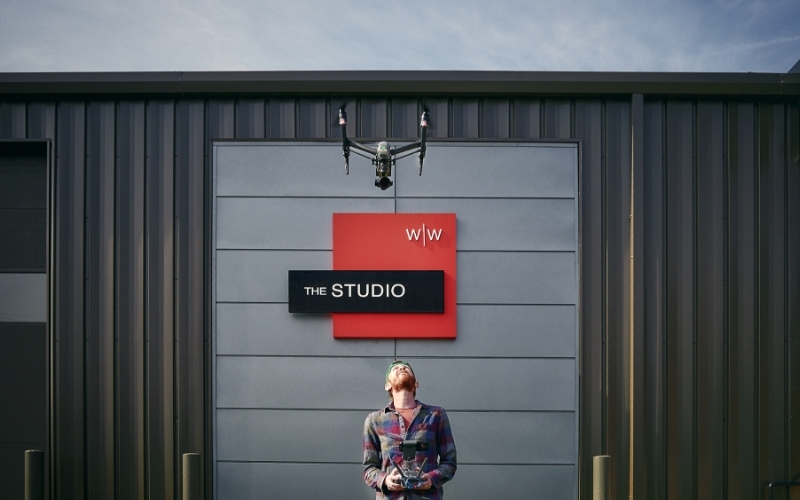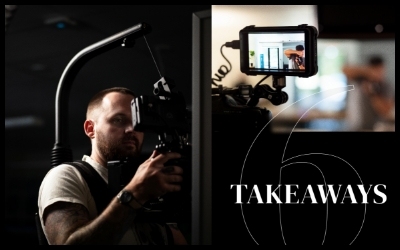Photography
Television and Video
Effective still photography and video can captivate and capture audiences in a cluttered, lightning-fast world where brands often have only a split second to express themselves before people move on to something else. But in a world where brand marketers and their creative partners are also moving at lightning pace, how can teams make quick but informed decisions on where to shoot?
If you’re weighing the pros and cons of shooting your photography or video project in studio or on location, here are eight things to consider.
- Control: A studio gives creative and production teams full control of the situation, which is not possible on location. In a studio, it’s often possible to move furniture and even walls. Fixed walls make certain camera angles and types of shots difficult to achieve. But a studio provides flexibility to create the exact desired effect, minus the complications that can sometimes pop up on location. There’s a certain sense of freedom that comes from setting up and shooting away, knowing the scene is perfectly lit and won’t change unless you want it to change.
- Lighting: At its best, photography is inspired by natural light. Whether it’s a magical shade of orange on the water’s surface for two fleeting minutes following sunset or the warm cast of tungsten lamps on a model’s skin, lighting can be the reason a photo inspires people or captures their attention for the wrong reasons. Lighting direction should play a big role in determining whether you shoot in studio or on location.
- Weather: We can’t control the weather. When we’re shooting photography outdoors, for example, the wind might kick up at exactly the wrong time, or it could rain. Subjects’ hair, makeup and clothing can be affected by outdoor elements. Sun glare might cause subjects to squint. But studio light is consistent light. Indoors, we don’t have to race the clock to beat sunset or deal with clouds. We can schedule a shoot for the most convenient time instead of when the sun is at its best. This can be particularly helpful during winter months, when the days are shorter.
- Cost: Space rental costs vary, but shooting on location can sometimes be cheaper than constructing large sets. On location, the space is already built. It may need some work, like new paint, or different furnishings, but much of what’s needed for the shoot already exists. Whereas, in a studio, everything must be built in the space or transported there. This includes not only the walls and furniture but also any texture that can only truly be achieved through years of activity in a space. And recreating a genuine environment inside a studio can sometimes be a costly endeavor. On the other hand, travel costs are one of the primary reasons location shoots become expensive, so make sure you factor this into your decision when evaluating or planning shoots on location.
- Convenience: Shooting in a studio is generally simpler than shooting on location. Props are readily available in the studio, while forgetting something important on a shoot in the middle of the desert can present a complex problem. Studios are also well equipped with backups to save the production from power failures or broken equipment. Convenient access to large-scale equipment makes shoots easier. Teams also don’t have to worry about permits, location insurance, traffic, noise, tents, supply trailers or motor home rentals. They don’t have to deal with parking or shuttling hassles or electrical limitations. They don’t have to contend with neighbors, homeowners or location reps who could potentially impede the production.
- Time: Studio work can save time, because everything — from extra equipment to crewmembers — is based in one place. Location shoots take more time from the outset, because they require finding the right spot. Then, once crews are on the set, they may have to frequently run back and forth to fetch props, leaving less time to actually shoot. Plus, it’s always possible to find an available studio, meaning there’s no need to worry about shoot dates. Conversely, locations are usually only available at the property owner’s convenience. If there are tenants on the property, their schedules may also complicate the matter.
- Privacy and Security: Shooting in a studio offers enhanced privacy and security. When we know onlookers and others aren’t peering over our shoulders, we can focus completely on the job at hand. We can control who has access to the set and avoid the potential issues caused by curious people. Communication to and from the photographer or model is also easier without outside distractions. Studios are more secure, too. When we are on a multiday project, studios allow us to lock up and secure equipment overnight without having to transport it to a more protected location.
- Authenticity: Engaging with the world at large produces a special kind of creative energy, and location shoots come with a life, energy and vibe all their own. Locations can represent the region of a city or country, create a mood and reinforce the team’s creative vision. Locations can provide iconic landmarks that are not easily replicated. It’s possible to build the perfect set, right down to the last detail, only for it to feel fake on-screen. The illusion of realism will always be easier to convey on location, because things like architectural detail and real-life wear and tear are hard to construct.
Your creative vision for a project or marketing campaign should be the chief concern as you determine whether to shoot in studio or on location. But it’s also important to consider things like cost, convenience and available tools.
Wray Ward shoots on location all over the world, and we also have a dedicated, near-2,500-square-foot studio space in Charlotte, North Carolina. Contact us to talk about how we can help turn your vision for a photography or video project into a reality.


